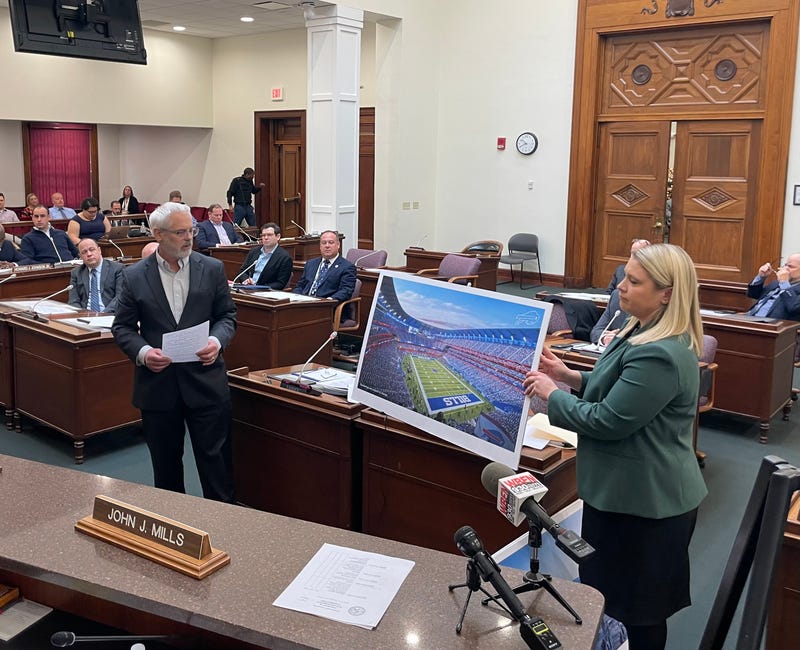
Buffalo, N.Y. (WBEN) - It was another step closer towards getting the future home of the Buffalo Bills up-and-running in Orchard Park.
Members of the Erie County Legislature gathered on Thursday to discuss the much anticipated State Environmental Quality Review (SEQR) for the new proposed Bills stadium during the Energy and Environment Committee meeting.

A number or presenters were on-hand for the SEQR review presentation, as they were able to explain what the SEQR was able to find and discover in the process, and how those will properly be addressed for the new stadium across the street from Highmark Stadium on Abbott Road.
During the nearly 75-minute presentation, the speakers also took the time to answer any questions of the Erie County Legislators with the information that was given to them.
"Generally speaking, the studies found that because the old stadium was designed and built more than 50 years ago, before we had environmental review statutes, the new stadium with its state-of-the-art design, sustainable practices, will actually be an environmental improvement in many instances," said Attorney Adam Walters from Phillips Lytle, who has past experience in land use and zoning matters pursuant to the SEQR Act.
After a quick presentation of the stadium renditions and the layout of the proposed stadium that is currently slated for the stadium lots across the street from the current facility, speakers started to break down the findings and why it was determined that the analysis done on all of the different environmental features did not show any impacts that would be considered significantly adverse:
Stadium location:
As part of an alternative analysis done, the SEQR review looked into the environmental impacts between building a new stadium in Orchard Park versus a new stadium in Downtown Buffalo.
"There's been a lot of calls for moving the stadium downtown, and we really wanted to have a review of what that would be, compared to building a new stadium in Orchard Park," Walters said. "In general, the analysis found that downtown locations have potential significant impacts from displacement of residents and businesses, to the introduction of significant noise sources and traffic sources into existing well-developed communities. In comparison, the new stadium in Orchard Park will not displace any residents or businesses, and the fabric of the community really has built up around the stadium over the last 50 years."
Lighting design:
According to the report, the new lighting technology and the controls coupled with the partial enclosure of the stadium, as opposed to the tall lighting structures currently at Highmark Stadium, will reduce the impacts of lighting in the area.
"Right now, the light poles are much higher than the stadium, and you can see that from the 219 and elsewhere," said Dan Castle, Erie County Commissioner for the Department of Environment and Planning. "The new stadium, the lights will be enclosed under the partial roof, so you won't have the light bleed that you see now."
Water pressure issues:
The new stadium in Orchard Park will be hooked off a main transmission line instead of the small feeder lines, which will prevent and solve current water pressure problems for residents and others in the immediate area around the stadium, especially on a game day.
"During the scoping meeting, some of the members of the public brought that to our attention. It was actually something that nobody at the Bills or the county was aware of, and so we were able to solve that problem through design," Walters pointed out.
Storm water and water runoff concerns:
There were a lot of questions regarding the current and potential increase in storm water flow concerns with any future rain or snow storms. There was uncertainty how that process was going to be resolved until the design process came into play.
"In doing the design and doing the study, we found not only can we handle the storm water flow coming from the new site, but we can actually fix some of the problems with the old stadium," Walters said. "I think peak storm water flow goes down by about 18%, which is fairly significant. Now we'll have water quality treatment, so before it goes to Smokes Creek, it's going to be treated, which is pretty cool."
Stadium vehicle traffic concerns:
While the traffic report as part of the SEQR showed it will generally be similar to the situation at Highmark Stadium, presenters feel it will be better that what's currently in place.
"There will be less traffic. The new stadium is smaller, so you have fewer people coming to a game. There's more ingress and egress to the new stadium site," Walters explained. "I think we mentioned during the presentation to the Legislature that Smokes Creek, which is currently East of the stadium, is actually an impediment to moving traffic, a lot of traffic can't leave the site in even directions. The new site across the street doesn't have that constraint, so there'll be more opportunity to have people leave more easily when everybody tries to get on the road after a game."
Stadium foot traffic concerns:
"Foot traffic will largely stay the same," Walters said. "There are on-site improvements at the stadium, so many who have walked to the new stadium or the existing stadium, you have to navigate your way through parking lots to get there. The new stadium will have a really comprehensive, widespread walkway network. That is definitely an improvement."
Stadium construction concerns:
There will be a detailed traffic plan with the idea to not bring all the traffic for stadium construction in through one area. It will be spread out from areas on Big Tree Road, 20A and Abbott Road to provide construction access for crews, and that will all be managed by the construction managers for the Bills.
"[They] will constantly manage the flow of traffic and ensure not only the vehicles are getting on site and not blocking roads as they're going, but when they leave, they need to clean so that they clean out stations before they leave, dust should not come off the site onto the roads. That will be actively monitored throughout the construction process," Walters said.
Grass turf field:
The stadium surface at the new complex will be natural grass, as opposed to the artificial turf that's there at Highmark Stadium.
"That was primarily for players safety, the NFL and the players are preferring natural grass. So that is the focus of the stadium, it will have natural turf," Castle said. "Part of that will be the [system] that will have to be heated to be above freezing, so that the grass surface can be maintained in appropriate condition."
However, in order to keep the field heated, especially in the winter to keep the field from freezing in the winter conditions outdoors, there will be a system in place that will blow air to keep the roots aerated throughout the year, as well as heat the field with gas fired boilers.
While the stadium will be using more natural gas to warm the stadium, the state has been trying to phase natural gas options elsewhere in favor of environmentally friendly options.
"I think the focus on natural gas as a fossil fuel and the climate act is a long-term transition. Dates are put out there, 2035, but it's a transition," Castle said. "There are certain uses like this that will have to have gas in that transition, and I think this is a case. The state has been involved in this process all throughout, they've had the chance to push for that. I think long-term, that is the state's goal is to wean off of fossil fuels. That should be the goal of all of us, really, in the long-term. It's just getting to there is the process we're dealing with now."
Archaeological sensitivity:
The state, county and the State Historic Preservation Office (SHPO) began a consultation process this summer with the Seneca Nation of Indians and other local Nations regarding the potential for uncovering indigenous artifacts as the construction process begins.
"There are two Native American cemeteries located off of Southwestern Boulevard at the site of the old stadium, and one at the side of the new stadium. So archaeological concerns were a significant concern to the community, and to the Nations, specifically. So we started a consultation process with the Nations early on, there's been a good open dialogue," Walters said. "They've had input on reports, and there will be a thorough investigation, if you will, prior to any construction to ensure that any archaeological remnants are dealt with appropriately."
"We also will have a, what's called, a Letter of Resolution between the state, the county and the Nations. It lays out the framework of how to address the finding of any other archaeological artifacts that may be found during construction that we aren't aware of yet," Castle added.
----------
So what's next in this process going forward? Where do things for the SEQR review go from here?
"The next step is the Legislature will vote on the SEQR documents, the environmental review documents and determine if there is, or not a significant environmental impact," Castle explained. "I think the meeting today went very, very well. Their questions were very good, and I think we were able to address them to their satisfaction. So they will vote, hopefully, next week on a negative declaration, which will hopefully bring an end to the SEQR part of this process."
Now that the Legislature has all the documentation it needs, when Legislators are ready to vote to finalize or approve the SEQR review, once they make the vote, that will kick in the new 30-day deadline to finalize the entirety of the new stadium deal.
You can listen to the entire presentation during Thursday's Legislature session available in the player below:

